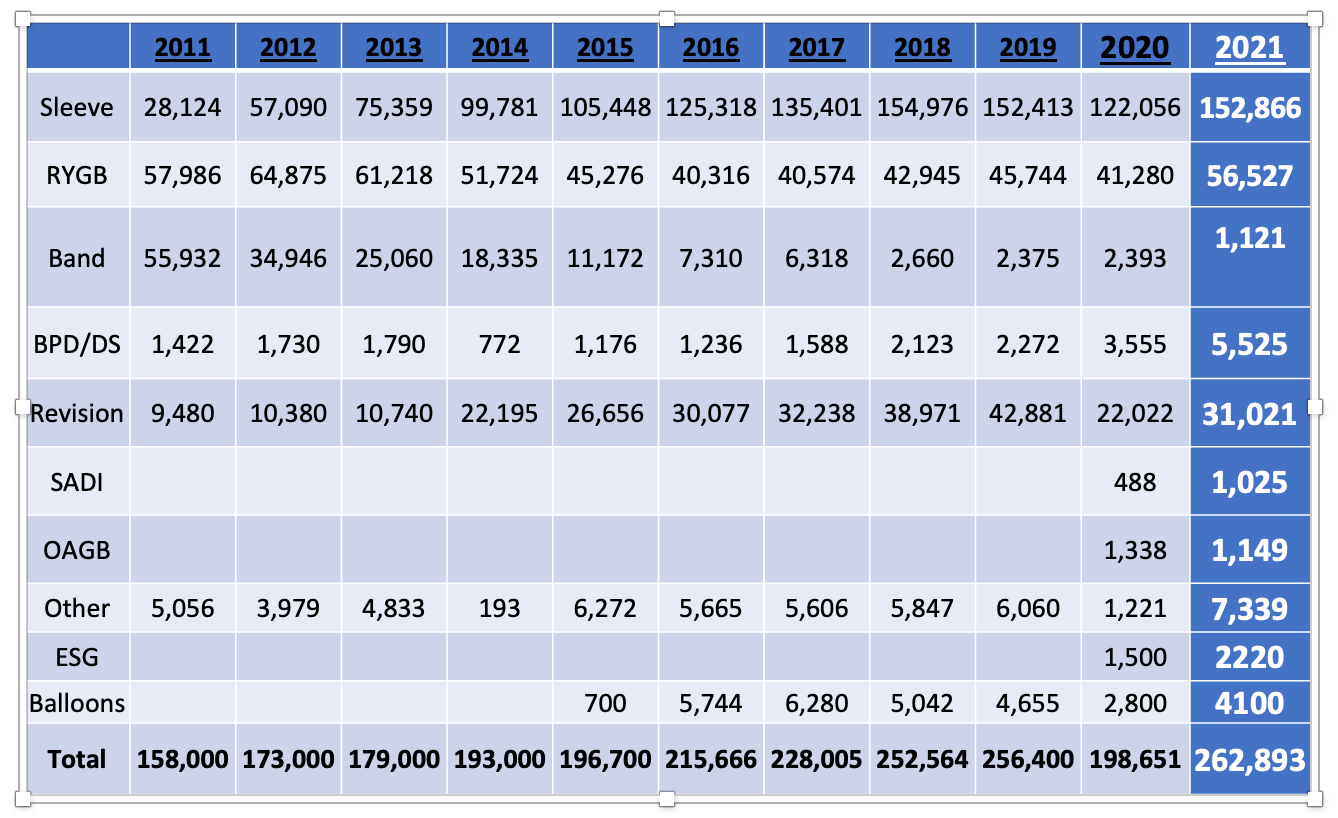A Ten-Year Journey: Understanding Weight Loss Surgeries in the U.S. (2011-2021)
Introduction
Bariatric surgery, a field that has seen significant advancements over the past decade, has become a cornerstone in the management of obesity and related metabolic disorders. This article presents an exhaustive analysis of the metabolic and bariatric procedures performed in the United States from 2011 to 2021, based on the best estimates provided by Dr. Ben Clapp at ASMBS 2023. The data encompasses a variety of procedures, each with its unique trends and implications for the future.
Detailed Analysis of Bariatric Procedures and Future Predictions
Sleeve Gastrectomy: Sleeve Gastrectomy, a procedure that involves removing approximately 80% of the stomach, has seen a steady rise in popularity. From 28,124 procedures in 2011, the numbers increased almost six-fold to 154,976 in 2018. Despite a slight dip in 2020, likely due to the COVID-19 pandemic, the numbers rebounded in 2021 with 152,866 procedures. The popularity of Sleeve Gastrectomy can be attributed to its simplicity, lower complication rates, and effectiveness in weight loss and improvement of comorbidities such as diabetes, hypertension, and sleep apnea. Given these advantages, we can expect the popularity of Sleeve Gastrectomy to continue to rise in the future, potentially becoming the most performed bariatric procedure.
RYGB: RYGB, a procedure that creates a small stomach pouch and reroutes the small intestine, has seen a gradual decline from 57,986 procedures in 2011 to 40,316 in 2016. However, the procedure has shown resilience with numbers gradually increasing to 56,527 in 2021. Despite the rise of Sleeve Gastrectomy, RYGB remains a highly effective procedure for weight loss and resolution of comorbidities. Its future relevance will likely depend on further improvements in surgical techniques and patient selection, as well as long-term data on weight loss maintenance and resolution of comorbidities.
Adjustable Gastric Banding: Adjustable Gastric Banding, a procedure that involves placing an adjustable band around the upper part of the stomach, has seen a significant decline over the decade, from 55,932 in 2011 to just 1,121 in 2021. The decline in Adjustable Gastric Banding can be attributed to the higher complication rates, lower efficacy in long-term weight loss, and the need for regular adjustments, which can be inconvenient for patients. Given these challenges, the future of Adjustable Gastric Banding appears to be limited, and it may eventually be phased out in favor of more effective procedures.
BPD/DS and Revision Surgeries: BPD/DS, a complex procedure that combines restrictive and malabsorptive elements, has seen a steady increase from 1,422 in 2011 to 5,525 in 2021. This trend is likely to continue, given its effectiveness in achieving substantial weight loss and resolution of comorbidities, particularly in patients with severe obesity. Revision surgeries, which are performed to correct or modify a previous bariatric procedure, have also increased from 9,480 in 2011 to 31,021 in 2021. As the number of primary bariatric procedures increases, the demand for revision surgeries is also likely to grow. This trend underscores the importance of careful patient selection and follow-up to ensure the success of the initial procedure and minimize the need for revisions.
SADI, OAGB, ESG, and Gastric Balloons: These newer procedures have seen varying levels of adoption. SADI and OAGB, introduced in 2020 and 2021 respectively, represent modifications of existing procedures aimed at improving outcomes and reducing complications. Their future growth will depend on further research demonstrating their long-term efficacy and safety. ESG, a non-surgical procedure that reduces the size of the stomach using an endoscope, saw a significant increase from 1,500 in 2020 to 2,220 in 2021. As a non-surgical procedure, ESG may appeal to patients seeking less invasive options, suggesting potential for further growth. Gastric Balloons, a non-surgical weight loss procedure, saw a peak of 6,280 procedures in 2016, but numbers have fluctuated since then. The future of Gastric Balloons will likely depend on advancements that improve their effectiveness and patient tolerance.
Total Bariatric Procedures and Future Predictions
The total number of bariatric procedures performed in the United States has seen a steady increase over the decade, from 158,000 in 2011 to 262,893 in 2021. This increase of over 66% indicates a growing acceptance and reliance on bariatric surgery as a treatment for obesity and related metabolic disorders. Given the ongoing obesity epidemic in the United States, we can expect the demand for bariatric surgery to continue to grow in the future. The increasing prevalence of obesity, coupled with the proven effectiveness of bariatric surgery in achieving weight loss and improving comorbidities, suggests that the upward trend in bariatric procedures is likely to continue.
Conclusion
The landscape of bariatric surgery in the United States has undergone significant changes over the past decade. While some procedures have seen a decline in popularity, others have emerged and gained acceptance. The overall increase in the total number of procedures indicates the growing recognition of bariatric surgery as an effective treatment for obesity. As we look to the future, it will be interesting to see how these trends evolve and what new advancements the field of bariatric surgery will bring. The continuous evolution of bariatric procedures, driven by advancements in surgical techniques and a better understanding of obesity and metabolic disorders, promises to bring more effective and safer options for patients in the future.





































































































